(HIpE) 2009 Program and Abstracts - Health Sciences - Curtin ...
(HIpE) 2009 Program and Abstracts - Health Sciences - Curtin ...
(HIpE) 2009 Program and Abstracts - Health Sciences - Curtin ...
You also want an ePaper? Increase the reach of your titles
YUMPU automatically turns print PDFs into web optimized ePapers that Google loves.
<strong>2009</strong>Faculty of<strong>Health</strong><strong>Sciences</strong><strong>Program</strong> & <strong>Abstracts</strong>25th August <strong>2009</strong>Bentley Campus<strong>Curtin</strong> Universityof Technology<strong>Health</strong> Interprofessional EducationStudent Conference
<strong>Curtin</strong> University of TechnologyFaculty of <strong>Health</strong> <strong>Sciences</strong>25 August <strong>2009</strong><strong>2009</strong>http://healthsciences.curtin.edu.au/faculty/ipe.cfm<strong>Program</strong> & <strong>Abstracts</strong>Contents 1Welcome 2IPE Initiatives Thus Far 3Keynote Speakers 4<strong>Program</strong> 5<strong>Abstracts</strong> 7-15Award for Best Presentation 15Venue Map & Acknowledgements 16Subtitle: <strong>Health</strong> Interprofessional EducationStudent Conference, <strong>Program</strong> & <strong>Abstracts</strong>Publication Date: 08/<strong>2009</strong>Subject: <strong>Health</strong>ISBN: [978-0-646-51987-6]© <strong>2009</strong> <strong>Curtin</strong> University of Technology<strong>Program</strong> text prepared by Margo Brewer.Layout <strong>and</strong> design by Cass<strong>and</strong>ra Doherty.Printed by Salmat Print on Dem<strong>and</strong>.<strong>Health</strong> Interprofessional Education (<strong>HIpE</strong> <strong>2009</strong>) — Student Conference 1
WelcomeWelcome to the <strong>2009</strong> Student Interprofessional Education Conference.Interprofessional Education (IPE) forms the foundation of many <strong>Curtin</strong>'s Faculty of <strong>Health</strong><strong>Sciences</strong> initiatives enabling health professionals to learn with, from <strong>and</strong> about each other.This involves the participants in an opportunity to share their knowledge <strong>and</strong> skills <strong>and</strong>gain a deeper underst<strong>and</strong>ing of the contribution each health discipline makes to the careof the patient.Evidence of the benefits of IPE have been reported around the world,specifically its role in the improvement in the safety <strong>and</strong> quality of health care delivery.<strong>Curtin</strong> University sees the development of IPE as key to its mission as it will facilitate thechanges needed in health professionals <strong>and</strong> health care practice in the future.The focus of this conference is on preparing students to work collaboratively in health careteams by providing the context for IPE developments internationally <strong>and</strong> locally <strong>and</strong>examples of IPE initiatives we have developed <strong>and</strong> implemented in the University.We trust the presentations will be thought provoking <strong>and</strong> inspire students to engage infuture interprofessional experiences <strong>and</strong> facilitate collaborate working which focuses on aholistic view of the patient <strong>and</strong> the quality of care received.Professor Jill DowniePro Vice-Chancellor<strong>Health</strong> Interprofessional Education (<strong>HIpE</strong> <strong>2009</strong>) — Student Conference 2
Interprofessional Initiatives Thus FarFieldworkA number of interprofessional fieldwork/clinical placements have been conducted including:(i) Go Global which provides students from occupational therapy, physiotherapy, speechpathology, pharmacy <strong>and</strong> nursing an opportunity to work <strong>and</strong> live together in aninternational setting;(ii) Therapy Focus <strong>and</strong> Brightwater Care Group which provided students from occupationaltherapy, physiotherapy <strong>and</strong> speech pathology with an opportunity to work in aninterprofessional team in a disability setting;(iii) Chronic Disease Management which provides student from occupational therapy,physiotherapy, pharmacy, nursing, podiatry <strong>and</strong> others to work in interprofessional teams ina community based care setting;(iv) Royal Perth Hospital’s “First five minutes” project which involves students fromphysiotherapy, nursing <strong>and</strong> medicine conducting an interprofessional simulation exercise;<strong>and</strong>,(v) <strong>Curtin</strong>’s Activity, Food <strong>and</strong> Attitudes <strong>Program</strong> which provides students formphysiotherapy, psychology, social work <strong>and</strong> dietetics with an opportunity to provide aninterprofessional service for adolescents with obesity <strong>and</strong> their families. A number of similarfieldwork placements are also in the development stage.Events<strong>Curtin</strong> held its first <strong>Health</strong> Care Team Challenge in June involving three interprofessionalteams of health science students competing in front of expert judges <strong>and</strong> a live audience topresent an integrated care plan for a patient with complex medical issues. The winningteam then travelled to Brisbane to compete against teams from a number of otherAustralian universities.WorkshopsInterprofessional education opportunities conducted on campus in 2008 <strong>and</strong> <strong>2009</strong> include: anumber of workshops utilising case based learning with focussing on analysis of clinicalerrors, communicating with patients, care of stroke survivors, diabetes management, <strong>and</strong>management of patients with swallowing problems.Innovative technologiesCurrently under development is an interprofessional virtual wound clinic utilising SecondLife (a 3D immersive world) where students will role play wound care scenarios. This projectis a collaboration with both students <strong>and</strong> lecturers from Kings College, London.Case study developmentA number case studies utilising st<strong>and</strong>ardised patients are being developed for use in arange of learning scenarios.Communication<strong>Curtin</strong> provides staff, students <strong>and</strong> the community with information relevant tointerprofessional education <strong>and</strong> collaborative practice via both its website http://healthsciences.curtin.edu.au/faculty/ipe.cfm <strong>and</strong> LMS Blackboard sites. These include awide range of information about IPE; archived lectures <strong>and</strong> seminars, examples of IPEe-learning, news <strong>and</strong> events locally, nationally <strong>and</strong> internationally, an e-reserve referencelist, learning materials <strong>and</strong> research as well as links to other agencies involved in IPE.<strong>Health</strong> Interprofessional Education (<strong>HIpE</strong> <strong>2009</strong>) — Student Conference 3
Keynote SpeakersDr Dorothy JonesDorothy originally trained as a doctor <strong>and</strong> spent many yearsworking in acute hospital medicine, rural public health, healthadministration <strong>and</strong> patient safety before joining <strong>Curtin</strong> University. Shehas held a number of senior health <strong>and</strong> medical roles including WAChief Medical Officer. In 2002 she was tasked withestablishing the Western Australian government’s approach topatient safety <strong>and</strong> health care quality <strong>and</strong> was appointed theFoundation Director of the Office of Safety & Quality in <strong>Health</strong>care – arole she still holds.In <strong>2009</strong>, Dorothy was appointed as <strong>Curtin</strong>’s inaugural Professor of Clinical Safety &Quality. She is passionate about developing team based collaboration <strong>and</strong>interprofessional learning approaches to improve patient safety <strong>and</strong> care experiences forpatients <strong>and</strong> their families <strong>and</strong> in 2010 will enrol students from all disciplines in the newpostgraduate education program in <strong>Health</strong> Improvement offered by the Faculty of <strong>Health</strong><strong>Sciences</strong>.Prof Dawn FormanDawn is a Key Associate of the Leadership Foundation for HigherEducation <strong>and</strong> Senior Associate of Ranmore Consulting <strong>and</strong> hasparticular expertise in strategic leadership, team development,interprofessional education, executive coaching <strong>and</strong> changemanagement with extensive practical experience within HigherEducation <strong>and</strong> <strong>Health</strong> Service fields. Some examples of the kind ofissues with which she has recent experience include:Working with clients undertaking major change <strong>and</strong> restructuring.Facilitating team development <strong>and</strong> conflict resolution.Coaching individual executives in considering <strong>and</strong> undertaking significant careermoves.Providing key note lectures <strong>and</strong> facilitating workshops for interprofessional Educationin the UK, Australasia <strong>and</strong> in developing countries.Facilitating Universities <strong>and</strong> awarding bodies with the employer engagement agenda.She has published extensively on many aspects of Leadership <strong>and</strong> Management <strong>and</strong> isrecognised internationally for her expertise in Interprofessional Education.Dawn has a MBA <strong>and</strong> PhD from Sheffield Hallam University Business School <strong>and</strong> heldthe post of Dean <strong>and</strong> Professor for 12 years whilst she worked at the University of Derby<strong>and</strong> Sheffield Hallam University. She was also a Non-Executive Director of TrentStrategic <strong>Health</strong> Authority for 4 years.Finally, Dawn has been recognised at professional level by 6 universities <strong>and</strong> iscurrently a visiting professor at the University of Chichester, <strong>and</strong> an Adjunct Professor atAuckl<strong>and</strong> University of Technology. Dawn is also a European representative for theNetwork:Towards Unity for <strong>Health</strong>, which is closely linked with the World <strong>Health</strong>Organisation <strong>and</strong> has been a board member of the Centre for the Advancement ofInterprofessional Education for 15 years.<strong>Health</strong> Interprofessional Education (<strong>HIpE</strong> <strong>2009</strong>) — Student Conference 4
<strong>Program</strong> — 25 August <strong>2009</strong>9.15 am Registration Venue: 405-Foyer10.00am Welcome: Professor Jill Downie – PVC, Faculty of <strong>Health</strong> <strong>Sciences</strong> Venue: 405-20110.10 am Keynote Address: Professor Dorothy Jones - Clinical Safety & Quality, Faculty of <strong>Health</strong> <strong>Sciences</strong>,<strong>Curtin</strong> UniversityTopic: Dying for Change: Why Patients Can’t Wait Venue: 405-201Parallel Sessions as Below1Venue 405-201Haydn Williams LT11.00 am Leading the Way throughInterprofessional Clinical StudentPlacements –Improving FutureCare in Chronic DiseaseManagement2Venue 401-002Hollis 2 LTStudents Go Global Society3Venue 401-001Hollis 1 LTThe First 5 Minutes: AnInter-professional Learning (IPL)Project Using Simulation11.30 am Policy, Process <strong>and</strong> Strategy –Critical Requirements of an IPLOrganisationExperiential Interprofessionalremote <strong>and</strong> Indigenous <strong>Health</strong>Education in the bush - CountryWeekInterprofessional experienceopportunities in <strong>Curtin</strong>’s Activity,Food <strong>and</strong> Attitudes <strong>Program</strong>: Amultidisciplinary program foroverweight <strong>and</strong> obeseAdolescents12.00 pm Interdisciplinary Care withinWestern Australia’s State MajorTrauma ServiceInterprofessional <strong>and</strong> InternationalClinical Education: Working, Living<strong>and</strong> Learning Together in China,India, South Africa <strong>and</strong> UkraineInterprofessional LearningExperience: Dietetics <strong>and</strong> HumanCommunication Science Students12.30 pm Lunch: Venue: 405-Foyer1.10 pm Plenary Session: Professor Dawn Forman PhD, MBA, PG Dip Research, TDCR, MDCRVice Chair CAIPE (Centre for the Advancement of Interprofessional Education)Topic: Interprofessional Education: International Developments Venue: 405-2012.00 pm An Interdisciplinary Approach toRehabilitation For People WithBrain Injury2.30 pm “Plastics in a Box” – DeliveringTelehealth Plastic SurgeryOutpatient Services3.00 pm Developing CollaborativePractice Capabilities in theClinical SettingGo Global Alumni ChapterInternational Capacity Buildingthrough Inter-professionalCollaborationIPE ‘Wound Clinic’ ProjectFaculty Development ofInterprofessional Education:Advancing <strong>Health</strong> Care ProfessionalPreparationStrengthening Mother-ChildRelationships in a Prison Setting-Collaboration Between SpeechPathology <strong>and</strong> Psychology<strong>2009</strong> <strong>Health</strong> Care TeamChallenge (HCTC): Addressingthe needs of a complex patientthrough multidisciplinary teamwork.The learning opportunitiesfor healthcare students.Student administered StutteringTreatment in combination withMindfulness Based CognitiveTherapy for adults who stutter3.30 pm Mindfulness-Based FunctionalTherapy (MBFT) for ChronicBack Pain: An integration ofpsychology <strong>and</strong> physiotherapypractices4.00pmConference Close<strong>Health</strong> Interprofessional Education (<strong>HIpE</strong> <strong>2009</strong>) — Student Conference 5
<strong>Abstracts</strong>Leading the way through interprofessional clinical student placements: Improving future carein chronic disease managementNerida CrokerSenior Occupational Therapist, Chronic Disease Management Team, Public <strong>Health</strong> & Ambulatory Care, NorthMetropolitan Area <strong>Health</strong> Service, WA <strong>Health</strong>Nerida.Croker@health.wa.gov.auThis presentation outlines new initiatives showcasing how the Chronic Disease Management Team hascollaborated with <strong>Curtin</strong> University to establish clinical placements where students have the opportunity toobserve <strong>and</strong> develop universal skills in chronic disease management through participating in interprofessionallearning opportunities.Students learn to identify common themes <strong>and</strong> clinical issues for people living with chronic conditions, <strong>and</strong> howto refer appropriately to various health professionals involved in their management. The placements focus on adifferent range of learning outcomes than traditional uni-disciplinary placements, including:Increased knowledge of the scope of practice of a range of health professions in managing chronic diseaseDevelopment of case management role awareness <strong>and</strong> skillsIncreased awareness of communication <strong>and</strong> teamwork between health professionsConceptual learning <strong>and</strong> integration of new information into discipline specific clinical practicereflection on values, beliefs <strong>and</strong> culture of their own <strong>and</strong> other professionsBy preparing students with this knowledge <strong>and</strong> skills, it is hoped that they will graduate as an emerging healthworkforce which is better equipped to meet the needs of an aging population <strong>and</strong> increase in chronic conditions,particularly in areas of unmet need <strong>and</strong> where workforce shortages affect care options, such as in rural areas.As this new initiative has the potential to be implemented across a range of settings, it therefore has thepotential to increase clinical student placement opportunities as placement is not solely dependent on disciplinespecificsupervision since mentoring can be provided by any member of the interprofessional team.Students Go Global SocietyThuy Tran <strong>and</strong> Amy Rushton<strong>Curtin</strong> University of Technologythuy.tran@student.curtin.edu.au, amy.rushton@student.curtin.edu.auStudents Go Global (SGG) is an interdisciplinary <strong>Curtin</strong> University Guild society aiming to enhance quality <strong>and</strong>meet the Go Global vision of sustainability. This service learning focused international interprofessional fieldworkplacement allows health science students from five different professions to deliver capacity building servicesthrough host sites to consumers in Ukraine, China, India or South Africa. The SGG committee comprises ofstudents from Physiotherapy, Pharmacy, Occupational Therapy <strong>and</strong> Speech Pathology. The committee <strong>and</strong> afundraise subcommittee works alongside people in developing countries, raises awareness of the Go Globalprogram, support student’s in their endeavours to engage in this lifelong learning international experience <strong>and</strong>make links between international health professionals. The Office bearers promote the sustainability of thesociety through promotional work within the Faculty student body. This provides potential Go Global members<strong>and</strong> the wider community a means of underst<strong>and</strong>ing <strong>and</strong> connection with the clinical sites <strong>and</strong> upcoming fundraisingevents. Fundraising representatives organise social events, professional development, to supportprogram development, <strong>Curtin</strong> students <strong>and</strong> the host sites. The interprofessional approach facilitates studentsconnections with potential colleagues before they participate in the Go Global experience <strong>and</strong> support studentsachieve global citizenship; appreciating the diversity of cultural <strong>and</strong> international communities.<strong>Health</strong> Interprofessional Education (<strong>HIpE</strong> <strong>2009</strong>) — Student Conference 6
<strong>Abstracts</strong>The First 5 Minutes: An Inter-professional Learning (IPL) project using simulationKatherine Holmes, Nicky Deacy, Maggie Briggs & Ted Stewart-WynneRoyal Perth HospitalIt is well accepted that in the health care environment significant harm to patients occurs, frequently as a resultof errors in communication. With the increasing complexity of health care delivery the need for close,collaborative team work in an inter-professional learning (IPL) environment is recognised <strong>and</strong> recommended.With finite resources the drive to develop innovative clinical placements for health care under- <strong>and</strong> postgraduatestudents is great [COAG ref]. This study is designed to address these interacting issues.The primary objectives are to improve the quality of team work by enhancing communication <strong>and</strong> collaborationbetween health professionals, whilst providing an introduction to IPL in a low risk, simulated learning environment.Teams of six medical, nursing <strong>and</strong> physiotherapy students or postgraduates are provided with a pre-readingpackage discussing the concept of inter-professional learning, the basic life support algorithm, the MedicalEmergency Team (MET) calling criteria <strong>and</strong> the iSoBAR h<strong>and</strong>over checklist. The participants introducethemselves <strong>and</strong> their professions. The emergency scenario, in which their patient collapses, is discussed briefly.The facilitator then commences the scenario in which all members are expected to contribute to immediatemanagement of the patient. During the scenario the pause <strong>and</strong> discuss method of assisting the team is used.(Ref) The Medical Emergency Team (MET) leader arrives <strong>and</strong> a concise h<strong>and</strong>over of information, gathered inthe first 5 minutes, is required to be presented. Video recordings of the scenario are used for debriefing. Thefocus is on communication, leadership, <strong>and</strong> teamwork i.e. non-technical performance. The assessment tool usedto gather information on the individual <strong>and</strong> team performances will be presented. Scenarios were conductedweekly over a three month period – April to June <strong>2009</strong>.The information gathered during the 3 month evaluation period will be presented, together with the data on thestudents’ self-evaluation of their non-technical skills <strong>and</strong> attitudes to inter-professional team-work.The importance of communication <strong>and</strong> effective team work as integral to optimal clinical outcomes will behighlighted, with anticipated positive data. The next step is to design a study to assess how such a process mayimprove patient outcomes.Policy, process <strong>and</strong> strategy: Critical requirements of an IPL organisationKendra BellNext ChallengeKendra.bell@nextchallenge.com.auNext Challenge (NC) is a private community service organisation established by four allied health professionalswith a commitment to interprofessional practice. The organisation operates across four programs – Family,School, Contract (Third party) <strong>and</strong> Agency Support services. Each program relies on partnerships with stakeholdersto enhance community access to allied health services.From induction to the organisation, to internal policy, resources <strong>and</strong> process - the culture <strong>and</strong> systems of NCestablish <strong>and</strong> exp<strong>and</strong> its inter-professional learning focus. NC includes continual professional development activitiesthat share knowledge, <strong>and</strong> attempt to minimise training <strong>and</strong> professional biases. This exploration of differencesacross professions becomes a thought provoking journey for many professionals <strong>and</strong> students whocome into contact with NC.Importantly structural supports for IPL are in place. Across-profession sharing of information <strong>and</strong> knowledge areembedded in both policy <strong>and</strong> company process. Some procedural strategies are commonly present in manyservices such as integrated medical records, case notes, <strong>and</strong> team or case meetings. Other strategies includethe; Organisation structure <strong>and</strong> multi-layered opportunities for leadership, Core communicating strategiesthrough intranet rather than other modalities, Highly individualised program specific processes Internal wikilibrary that fosters <strong>and</strong> exp<strong>and</strong>s cross-fertilisation of knowledge <strong>and</strong> ideas across professions.This presentation will provide students embarking on clinical placements, <strong>and</strong> future graduates of allied healthprofessions - an awareness of how IPL is critically important for the organisation as a workplace. Strategies ofhow IPL can be integrated into a personal professional development journey will be demonstrated.<strong>Health</strong> Interprofessional Education (<strong>HIpE</strong> <strong>2009</strong>) — Student Conference 7
<strong>Abstracts</strong>Experiential interprofessional remote <strong>and</strong> Indigenous health education in the bush - CountryWeekHelen McHugh, Hamish Morgan, Corrina Pesich, Ivan Lin & Des ThompsonCombined Universities Centre for Rural <strong>Health</strong> - CUCRHNowhere is there a greater priority for health professionals to work together effectively as a team than in remotehealth service delivery. But underst<strong>and</strong>ing remote health is complex. Whilst epidemiological data clearlydemonstrates the poorer health status of those in remote regions, particularly for Aboriginal people,underst<strong>and</strong>ing the factors underpinning this scenario is hard to appreciate from a book. Furthermore thesestatistics fail to elaborate on the powerful connections people have to living in remote areas as well as thepotential benefits these places can have on health <strong>and</strong> well being, <strong>and</strong> this relationship may be used to facilitatedelivering health care in this context.Since 2002 the Combined Universities Centre for Rural <strong>Health</strong> has offered a program called Country Week toaddress this. Country Week is an annual one week intensive interprofessional program that focuses on remote<strong>and</strong> Indigenous health, <strong>and</strong> is offered in a remote or rural place. It is offered to all Australian resident studentsstudying health courses in the five major Western Australian universities. Country Week is underpinned by anumber of guiding principles. It is firmly based on experiential interprofessional education. It is offered as muchas is possible as a partnership with people <strong>and</strong> organizations in remote regions where we carefully considernotions of reciprocity between students <strong>and</strong> community. The process of reflection is key to facilitating learning.This presentation will focus on the immediate impact of Country Week on students, discuss brieflyconsiderations in delivering this program, <strong>and</strong> more broadly, our views on the place of such programs inaddressing remote <strong>and</strong> Indigenous health.Interprofessional experience opportunities in <strong>Curtin</strong>’s Activity, Food <strong>and</strong> Attitudes <strong>Program</strong>:A multidisciplinary program for overweight <strong>and</strong> obese adolescents.Melissa Davis, Mahi Weiss, Leon Straker & Margo Brewer<strong>Curtin</strong> University of TechnologyApproximately 25% of all Australian young people are overweight or obese. This historically unprecedented rateis believed to be contributed to by changes to environmental <strong>and</strong> societal factors such as a decrease in physicalactivity, an increase in sedentary behavior <strong>and</strong> the availability of high fat, high energy food. Overweight <strong>and</strong>obese adolescents are likely to become obese adults, <strong>and</strong> are at an increased risk for a range of short-term <strong>and</strong>long-term psychosocial <strong>and</strong> medical problems. Therefore, treating obesity in adolescence is an important priorityfor health-care providers. Given the multiple factors contributing to adolescent obesity, best practice guidelinesspecify that treatments offered in a family context <strong>and</strong> incorporating strategies from multiple domains are mostlikely to be efficacious. This presents a challenge for health professionals to effectively work together to presentan intervention.Staff <strong>and</strong> students from physiotherapy, dietetics, psychology, social work, health promotion <strong>and</strong> medicalprofessionals have developed a program for overweight <strong>and</strong> obese adolescents <strong>and</strong> their parents, based on aprogram developed at Princess Margaret Hospital for Children. Participants attend two-hour sessions, twice aweek for 8 weeks, involving exercise sessions for adolescents, <strong>and</strong> education sessions for adolescents <strong>and</strong> parents.The program aims to create changes in family habits which will lead to long term <strong>and</strong> sustainable changes.Developing <strong>and</strong> implementing the multidisciplinary intervention has provided staff <strong>and</strong> students excellentopportunities to learn about other health professions <strong>and</strong> how multidisciplinary collaboration can maximizepositive outcomes for clients.<strong>Health</strong> Interprofessional Education (<strong>HIpE</strong> <strong>2009</strong>) — Student Conference 8
<strong>Abstracts</strong>Interdisciplinary Care within Western Australia’s State Major Trauma ServiceSonja De Munck & Jessica HoldingRoyal Perth HospitalJessica.Holding@health.wa.gov.auPatients who have sustained injuries to multiple body systems through trauma are a complex, high cost group ofpatients that often require multiple procedures, interventions <strong>and</strong> resources throughout their hospital admission.In November 2004, Royal Perth Hospital was designated the state’s Adult Major Trauma Centre. The traumaservice consisted of a specialist medical team, trauma case manager <strong>and</strong> senior occupational therapist. Traumapatients were scattered around the hospital making it difficult to effectively coordinate interdisciplinary care <strong>and</strong>discharge planning. In February 2008, Western Australia’s 30 bed State Major Trauma Unit was openedboasting both a team of specialist general <strong>and</strong> orthopaedic surgeons, as well as occupational therapists,physiotherapists, social workers, clinical psychologists, pastoral care, a speech therapist, pharmacist <strong>and</strong>dietician.The aim of the State Major Trauma Service is to ensure the medical, physical, cognitive, functional <strong>and</strong>psychosocial needs of the patient are met in an effective <strong>and</strong> timely manner through communication <strong>and</strong>collaboration between health professionals, the patient <strong>and</strong> family. It is anticipated that in addition to benefits tothe patient, costs to the health care system are reduced by minimising duplication of services <strong>and</strong> decreasinghospital length of stay. A case management model is utilised where patients <strong>and</strong> their family members liaisedirectly with one team member who is then able to communicate with relevant team members. Anecdotalevidence suggests this model is effective in ensuring the patient remains informed <strong>and</strong> empowered throughouttheir hospital journey. An overview of interdisciplinary care provided by the State Major Trauma Service will bediscussed.Interprofessional <strong>and</strong> international clinical education: Working, living <strong>and</strong> learning togetherin China, India, South Africa <strong>and</strong> UkraineNigel Gribble & Trevor Goddard<strong>Curtin</strong> University of Technologyn.gribble@curtin.edu.auFlint states “…an urgency exists for innovative interdisciplinary education approaches that "mimic" life in thecommunity <strong>and</strong> the natural environment so that the boundaries between education <strong>and</strong> community life becomeless defined <strong>and</strong> therefore, more integrated.” Annually, 90 allied health students from the <strong>Curtin</strong> UniversityFaculty of <strong>Health</strong> Science undertake Go Global - a four week clinical education placement in China, India, SouthAfrica or Ukraine. With interdisciplinary practice widespread in the Australian healthcare system, it is imperativethat students demonstrate relevant skills <strong>and</strong> behaviours to work effectively as healthcare workers.<strong>Curtin</strong>’s interprofessional international program provides a unique opportunity for Occupational Therapy,Physiotherapy, Pharmacy, Nursing <strong>and</strong> Human Communication Science students to live <strong>and</strong> work together inculturally diverse social <strong>and</strong> health milieus allowing the roles, skills <strong>and</strong> philosophy of the respective disciplinesto be understood.The international clinical education program evolved from the service learning models of Kenworthy-U’ren <strong>and</strong>Peterson <strong>and</strong> Godfrey et al. Each student cohort completes a cultural orientation program before travelling tothe host sites. Students deliver services to the clients <strong>and</strong> children in the same location year after year. For thefinal three weeks, students practice autonomously with guidance from the clinical supervisor provided via phoneor email exchanges. The interprofessional make-up of each cohort enhances the quality of services delivered toeach resident or child. It is the autonomous practice <strong>and</strong> reciprocity factors that allow the program to meet Flint’schallenge bringing diverse allied health students together.This innovative interprofessional education program is creating professionals with the <strong>Curtin</strong> Graduate Attributeof ‘recognising <strong>and</strong> applying international perspectives’ able to practice in a globalised environment asinternational citizens.<strong>Health</strong> Interprofessional Education (<strong>HIpE</strong> <strong>2009</strong>) — Student Conference 9
<strong>Abstracts</strong>Interprofessional learning experience: Dietetics <strong>and</strong> Speech Pathology StudentsRobynne Snell, Erin Godecke & Margo Brewer<strong>Curtin</strong> University of Technologyr.snell@curtin.edu.aue.godecke@curtin.edu.aum.brewer@curtin.edu.auInterprofessional education (IPE) has been defined as “occasions when two or more professions learn with, from<strong>and</strong> about each other to improve collaboration <strong>and</strong> the quality of care” (CAIPE, 2002). To enhance the quality ofhealthcare <strong>and</strong> improve health outcomes for patients, health professionals are being urged to workcollaboratively. In Australia, IPE has been practiced since the late 1970’s with attention increasing in recentyears with the health care crisis, workforce shortages, <strong>and</strong> health system reforms being the key drivers forchange. IPE has been regarded as a central <strong>and</strong> enabling str<strong>and</strong> of health workforce reform needing to beaddressed urgently by the higher education sector (L-TIPP, 2008).The Faculty of <strong>Health</strong> <strong>Sciences</strong> at <strong>Curtin</strong> University has identified IPE as a priority for the purpose of learningabout the knowledge, skills <strong>and</strong> roles of other professions. An opportunity for IPE was created in 2008 fordietetics <strong>and</strong> speech pathology students on the management of patients with dysphagia (swallowing difficulties).Students completed pre <strong>and</strong> post workshop questionnaires to assess their knowledge of the roles <strong>and</strong>responsibilities of each profession, their willingness to seek the advice of the other profession, <strong>and</strong> the benefitsof working interprofessionally. Students demonstrated a change in knowledge relating to discipline specific roles,the value of collaborative clinical work <strong>and</strong> working within an interprofessional team. There was a very high levelof satisfaction with the learning experience. The workshop between these two professions modelled a workplacepartnership <strong>and</strong> prepared health professional graduates for collaborative practice within the complex health caresystem.An interdisciplinary approach to rehabilitation for people with brain injuryJanet Wagl<strong>and</strong>Brightwater Care Group (Inc.)janet.wagl<strong>and</strong>@brightwatergroup.comPeople with brain injury experience impairment in skills ranging from walking to decision making around financialmanagement. Professionals working in isolation confined by disciplinary parameters assist people with braininjury in relearning individual skill components yet forget the importance of connecting those skills to achievefunctional outcomes.Brightwater Oats St, a community based residential rehabilitation program, has adopted an interdisciplinaryapproach to service delivery. Using a Case Coordination model, staff work with clients to clearly identify not onlyessential life skills but also personal goal driven outcomes. Smaller objectives supporting these outcomes arethen detailed enabling the team to work together interconnecting all required skills. This approach supportsclients in attaining independence that is functional, transferable across a variety of outcomes <strong>and</strong> relevant to anultimate goal of living independently in the community.As the rehabilitation program has developed the importance of this skill network in moderating risk <strong>and</strong> realizingan overall goal of sustainable independence has become clear. This is never more evident than whenconsidering issues such as the importance of effective decision making accompanying independent mobility <strong>and</strong>supporting skills such as road crossing.Brightwater’s involvement as the second agency to provide interdisciplinary clinical placement as part of theTeaching For the Future project will enable staff at Oats St to pass on this approach to a new generation ofprofessionals. Ultimately the soon to be established Brightwater Institute will encompass this program supportingcarry over to all areas of the organization including residential aged care.<strong>Health</strong> Interprofessional Education (<strong>HIpE</strong> <strong>2009</strong>) — Student Conference 10
<strong>Abstracts</strong>Go Global Alumni Chapter: International capacity building through inter-professionalcollaborationKristy Tomlinson & Caris BaldockGo Global Alumni Chapterkristy.tomlinson@therapyfocus.org.au, Caris.Baldock@riotinto.comThe Go Global Alumni chapter was launched in November 2008 to support <strong>and</strong> enhance the Faculty of <strong>Health</strong><strong>Sciences</strong> Go Global program while developing a network of Go Global graduates that st<strong>and</strong>s at over 200. TheAlumni chapter links students from a range of courses involved in the program, including; Speech Pathology,Physiotherapy, Pharmacy, Occupational Therapy <strong>and</strong> Nursing. In 2008, Go Global established an inter-facultycollaboration, with students from the School of Film, Television <strong>and</strong> Screen Arts accompanying students toChina to document the student experiences. The Alumni chapter encourages inter-professional awareness <strong>and</strong>practical collaboration between disciplines in adopting a holistic approach to capacity building for the host sites,while achieving <strong>Curtin</strong> graduate attributes.A current Alumni project supports an employee of An<strong>and</strong>aniketan (Go Global India) to maintain <strong>and</strong> deliver theinter-professional intervention recommendations of students. This project promotes the autonomy of staff atAn<strong>and</strong>aniketan <strong>and</strong> supports the Go Global mission of capacity building. Furthermore it provides an opportunityfor <strong>Curtin</strong> students <strong>and</strong> staff at An<strong>and</strong>aniketan to work with each other in the spirit of service learning.Go Global graduates are recognised within the community as resourceful <strong>and</strong> innovative professionals withremarkable skills in inter-professional practise <strong>and</strong> analytical thinking <strong>and</strong> are linking their employers to the GoGlobal program as well as providing professional support <strong>and</strong> mentorship to students in the program.Go Global Alumni members have gone on to be successfully selected in AusAID teams, been appointedAustralian Youth Ambassadors for Development <strong>and</strong> returned to a host site as volunteers in a professionalcapacity.Strengthening mother-child relationships in a prison setting- collaboration between speechpathology <strong>and</strong> psychologyNatalie Ciccone, Am<strong>and</strong>a Lloyd, Lynn Priddis, Ashleigh Taylor & Georgina St<strong>and</strong>ish<strong>Curtin</strong> University of TechnologyN.Ciccone@curtin.edu.au, A.Lloyd@curtin.edu.au, L.Priddis@curtin.edu.au,Ashleigh.Taylor@student.curtin.edu.au, georgina.st<strong>and</strong>ish@postgrad.curtin.edu.auThis presentation outlines the development of a joint Speech Pathology <strong>and</strong> Psychology interprofessional clinicbased at Boronia pre- release center, highlighting the process of relationship building between multipleagencies. Boronia is a low security women’s prison focused on promoting rehabilitation <strong>and</strong> communityreintegration. Up to six women are able to have their children, aged 0-4, live with them at the centre. Extra EdgeCommunity Services is a not for profit organisation that provides support programs to residents at Boronia, suchas the Pine Tree Tots program - aimed at building the mother/child relationship <strong>and</strong> develop the mother’sparenting skills. Liaison between staff at Extra Edge <strong>and</strong> <strong>Curtin</strong>’s School of Psychology identified an opportunityfor students across the two disciplines to support the services offered by Extra Edge. The development of theclinical placement has required close collaboration between disciplines <strong>and</strong> service providers to develop aclinical placement that meets the needs of the clients as well as the individual disciplines <strong>and</strong> service providers.Each of these elements has presented unique challenges <strong>and</strong> opportunities for student learning. Thispresentation will explore the positive experiences <strong>and</strong> challenges of developing the clinic from a staffperspective as well as a reflection on the learning opportunities from a student view point.<strong>Health</strong> Interprofessional Education (<strong>HIpE</strong> <strong>2009</strong>) — Student Conference 11
<strong>Abstracts</strong>“Plastics in a Box” – Delivering Telehealth Plastic Surgery Outpatient ServicesHeather MacLaren, Senior Occupational Therapist, Judith Elliott, Senior Occupational Therapist,Beth Sperring, Clinical Nurse Consultant, Alan Hamilton, Telehealth Coordinator,Royal Perth HospitalHeather.Maclaren@health.wa.gov.auRoyal Perth Hospital commenced multidisciplinary Plastic Surgery outpatient Telehealth clinics in 2008, toimprove access to specialist services for rural <strong>and</strong> remote patients in Western Australia. The service averages1500 patient appointments per year. An advanced practitioner model for nurse <strong>and</strong> occupational therapist ledclinics, along with the development of clinical pathways is in use.With the majority of WA’s tertiary hospital services <strong>and</strong> specialist medical services located in Perth, a patientmay travel 3200km to Perth for an appointment, which is more expensive <strong>and</strong> inconvenient for rural <strong>and</strong> remotepatients compared to their metropolitan counterparts. Ensuring patients receive quality coordinated care requiresservice providers to re-examine traditional processes <strong>and</strong> practises.Plastic Surgery Telehealth clinics are multidisciplinary <strong>and</strong> include a Plastics Consultant, Clinical NurseConsultant, Occupational Therapist, technical <strong>and</strong> administrative support. Services are delivered via interactivereal time videoconferencing with store <strong>and</strong> forward of radiological <strong>and</strong> digital photographic images. With thischange to traditional patient follow up, engaging rural clinicians to support the service is vital. The service hasbecome the preferred option for most rural <strong>and</strong> remote Plastic Surgery patients in WA. Further development willinvolve exp<strong>and</strong>ing the clinical pathways, <strong>and</strong> continuing training <strong>and</strong> support of local health providers.Rural patients <strong>and</strong> practitioners are very supportive of Telehealth services. Transforming patient care whileretaining quality <strong>and</strong> equity for all is shown through the implementation <strong>and</strong> rapid expansion of this service. It ispossible <strong>and</strong> viable to deliver expert care in Plastic Surgery via Telehealth.IPE ‘Wound Clinic’ projectAlan Tulloch & Robin Watts<strong>Curtin</strong> University of TechnologyA.Tulloch@curtin.edu.au, R.Watts@curtin.edu.auOne of the aims of establishing the Silver Chain/<strong>Curtin</strong> Wound Clinic in 2007 was to develop interprofessionaleducation activities. Several IPE projects were set in motion in 2008. The primary project is aimed at providingstudent groups with access to scenarios <strong>and</strong> learning materials on wound management using audiovisualtechnologies. Another component is to enable observation <strong>and</strong> discussion of consultation sessions from anylecture theatre on campus. In addition the clinic can provide interprofessional placements. A second project thathas evolved is the use of Second Life for learning purposes. This is a joint project between <strong>Curtin</strong> <strong>and</strong> KingsCollege London. Students from Nursing <strong>and</strong> Pharmacy will form teams of three to work on six modules over asemester, accessing the ‘patient’ <strong>and</strong> related information via <strong>Curtin</strong>’s virtual Wound Clinic on the ‘Bentley South’Second Life isl<strong>and</strong>. The presentation will outline progress on the two projects together with images to illustratethe content <strong>and</strong> processes employed to engage students <strong>and</strong> support their learning. The interprofessionalcooperation involved in the development of these projects will also be discussed.TeamKeryln Carville Silver Chain/<strong>Curtin</strong> University of Technology kcarville@silverchain.org.auAlan Tulloch <strong>Curtin</strong> University of Technology .A.Tulloch@curtin.edu.auRobin Watts <strong>Curtin</strong> University of Technology R.Watts@curtin.edu.auNick Santamaria <strong>Curtin</strong> University of Technology/RPH N.Santamaria@curtin.edu.auKerry Reid-Searle Central Queensl<strong>and</strong> University k.reid-searl1@cqu.edu.auLeah Irving <strong>Curtin</strong> University of Technology L.Irving@curtin.edu.auKim Flintoff <strong>Curtin</strong> University of Technology K.Flintoff@curtin.edu.auJuliet Keaton WoundsWest/<strong>Curtin</strong> University of Technology J.Keaton@curtin.edu.auPatricia Reynolds Kings College London p.a.reynolds@kcl.ac.ukPascale Ng Cheong Tin <strong>Curtin</strong> University of Technology P.NgCheongtin@curtin.edu.auJohn Garyl Lin Wen Ying <strong>Curtin</strong> University of Technology rgaryl@hotmail.com<strong>Health</strong> Interprofessional Education (<strong>HIpE</strong> <strong>2009</strong>) — Student Conference 12
<strong>Abstracts</strong><strong>2009</strong> <strong>Health</strong> Care Team Challenge (HCTC): Addressing the needs of a complex patientthrough multidisciplinary teamwork. The learning opportunities for healthcare students.Kylie du Plessis, Russol Hussain, Kerry Ivey, Stewart Pryor, Bianca Ravi & Angus Hann<strong>Curtin</strong> University of Technology.The use of a multidisciplinary healthcare team to address patient needs has been shown to result in the bestpossible outcomes. Optimal teamwork requires each health professional to underst<strong>and</strong> the contribution otherteam members can make to address patient needs. The <strong>Curtin</strong> <strong>2009</strong> HCTC provided final-year health sciencestudents with an opportunity to work with other disciplines to develop holistic care plans for a patient withcomplex physical, psychological <strong>and</strong> social issues. Through team collaboration, key issues were prioritised <strong>and</strong>a care plan developed. The teams then presented their plan to a panel of expert judges in front of a liveaudience. The winning team, Team Rehab, then competed against 4 other Australian universities. As a result ofour involvement in the competitions, the members of Team Rehab have developed the capability to work <strong>and</strong>communicate effectively within a multi-disciplinary team. On a personal level, all members developed greatfriendships <strong>and</strong> life-long professional contacts. The experience will not only aid us in obtaining employment, butalso in ensuring the best health care outcomes for our patients in the future. In this presentation Team Rehabwill share their personal <strong>and</strong> professional experience from the events whilst highlighting the importance ofinter-professional collaboration in achieving optimal patient care.Developing collaborative practice capabilities in the clinical settingJustine Lambert, Therapy Focus Incorporated,Samantha Del Mol, Emma White & Margo Brewer<strong>Curtin</strong> University of TechnologyJustine.Lambert@therapyfocus.org.au, samantha.demol@student.curtin.edu.au;emma.j.white@student.curtin.edu.au & m.brewer@curtin.edu.auCollaborative practice is widely recognised as an essential ingredient in the delivery of high quality patient care.To prepare graduates for entry into the workforce universities must provide opportunities for students to develop<strong>and</strong> demonstrate their ability to work closely with other professionals in teams. A small group of students from<strong>Curtin</strong> University were allocated to an interprofessional team for a fieldwork placement at Therapy Focus, anagency which provides speech pathology, occupational therapy, physiotherapy, clinical psychology <strong>and</strong>specialised equipment to children with a range of physical <strong>and</strong> intellectual disabilities, learning problems <strong>and</strong>developmental delays. The Therapy Focus staff work in interprofessional teams <strong>and</strong> thus provide an idealsetting for piloting interprofessional placements.Each team consisted of one student from physiotherapy, occupational therapy <strong>and</strong> speech pathology. A brieforientation to interprofessional education was provided followed by a five week placement where studentsworked to develop both their discipline specific <strong>and</strong> their interprofessional competencies. Assessment of bothsets of competencies was conducted along with students’ attitude to interprofessional learning. At the conclusionof the placement feedback was gathered from both the students <strong>and</strong> their fieldwork supervisors. Thispresentation will explore the positive <strong>and</strong> challenging aspects of conducting an interprofessional clinicalplacement from both a staff <strong>and</strong> student perspective.<strong>Health</strong> Interprofessional Education (<strong>HIpE</strong> <strong>2009</strong>) — Student Conference 13
<strong>Abstracts</strong>Faculty development of interprofessional education: Advancing health care professionalpreparation.Interprofessional Education Excellence in Teaching Team - <strong>Curtin</strong> University of TechnologyMaria Chilvers School of Nursing & Midwifery, Peter Gardner School of Physiotherapy,Professor Jeff Hughes School of Pharmacy, Beatrice Tucker Office of Teaching <strong>and</strong> LearningMr Alan Tulloch School of Nursing & Midwifery<strong>Curtin</strong> University of TechnologyM.Chilvers@curtin.edu.au, P.Gardner@curtin.edu.au, J.D.Hughes@curtin.edu.au, B.Tucker@curtin.edu.au,A.Tulloch@curtin.edu.au<strong>Health</strong> professionals need to underst<strong>and</strong> the roles <strong>and</strong> responsibilities of each other <strong>and</strong> how to collaborate todeliver the best outcomes for patients. To advance health science students’ knowledge, skills <strong>and</strong> attitude tocollaborative practice a number of interprofessional education workshops have been conducted over the pasttwo years at <strong>Curtin</strong>. These were initiated by staff from Pharmacy <strong>and</strong> then developed in conjunction withNursing, Physiotherapy, Occupational Therapy, Social Work, Psychology, Speech Pathology <strong>and</strong> Dietetics.Students who were 3 rd year or final year have been invited to participate as it was thought that they havecovered an appropriate level of theoretical content in their course prior to the workshops. Medical students fromthe University of Notre Dame <strong>and</strong> the University of WA were also invited to participate.To date small groups of students have been given the opportunity to participate with a view to keeping the sizeof groups manageable to maximise discussion. The workshops thus far have covered the topics of medicationsafety, multidisciplinary care <strong>and</strong> communication, <strong>and</strong> patient-centered care of stroke. The workshops havebeen complex case study based <strong>and</strong> have involved a mixture of small group interdisciplinary discussion <strong>and</strong>problem solving as well as presentations by invited experts in complex case study management. Feedback fromparticipants has been positive with many reporting the perceived value of entering clinical placements with anincreased knowledge of the role of other professions in case management. The outcomes of these workshopsalong with plans for the future will be presented.Student administered stuttering treatment in combination with mindfulness based cognitivetherapy for adults who stutter.Janet Beilby, School of Psychology, Dr Michelle Byrnes, School of Psychology,Stephanie Borrello, 4 th year Speech Pathology Student & Kate Young, 4 th year Speech Pathology Student<strong>Curtin</strong> University of Technologyj.beilby@curtin.edu.au, m.byrnes@curtin.edu.au, stephanie.borrello@student.curtin.edu.au,kate.young@student.curtin.edu.auThe presentation describes an 8 week Interprofessional treatment programme for 10 adults who have lived withthe disability of a life-long clinically diagnosed stutter. Stuttering affects one in every 100 people worldwide <strong>and</strong>the consensus is that stuttering h<strong>and</strong>icaps not only the fundamental right a person has to speak freely, but alsotheir ability to cope positively in society at large. The person who stutters often incurs bullying <strong>and</strong> ostracismduring their school years <strong>and</strong> they are h<strong>and</strong>icapped educationally with 70% of adults who stutter having difficultygaining meaningful employment.Four final year speech pathology students ran the programme with supervision from <strong>and</strong> collaborative clinicalpractice with specialists from neuroscience, psychology <strong>and</strong> speech pathology. The students <strong>and</strong> their clientsattended each Wednesday evening for 8 concurrent sessions in the <strong>Curtin</strong> University Stuttering TreatmentClinic.Mindfulness Based Cognitive Therapy was delivered with contemporary Stuttering Treatments tailored for eachadult stuttering client. This unique multidisciplinary holistic approach addressed the fluency needs of the clientsat the same time as their communication fears, anxieties <strong>and</strong> social interaction difficulties were being managed.At the end of the 8 weeks, all clients showed significant gains in speech fluency but equally satisfying were thepositive quality of life changes the clients demonstrated in their daily social <strong>and</strong> emotional connections withsociety.<strong>Health</strong> Interprofessional Education (<strong>HIpE</strong> <strong>2009</strong>) — Student Conference 14
<strong>Abstracts</strong>Mindfulness-Based Functional Therapy (MBFT) for chronic back pain: An integration of psychology<strong>and</strong> physiotherapy practicesDr Clare Rees, Dr Jenny Thornton & Robert Schütze, School of PsychologyAssociate Professor Peter O'Sullivan, Dr Helen Slater, Prof Tony Wright , Bronwyn Middleton & KathrynDevereaux, School of Physiotherapy<strong>Curtin</strong> University of TechnologyThis project aims to explore the feasibility <strong>and</strong> utility of running a group-based blended psychology <strong>and</strong>physiotherapy intervention for patients with chronic low back pain. Although some components of thisintervention have been previously used in research <strong>and</strong> clinical settings, this is a novel combination of therapiesthat aims to integrate psychological <strong>and</strong> physio-therapuetic approaches in a way that is more effective thanusing each modality separately. Therefore an important aim of this pilot study is to develop <strong>and</strong> refine thismultidisciplinary protocol. Specifically, the aim is to create a protocol for an intervention that uses mindfulnessbasedcognitive <strong>and</strong> functional training to improve outcomes in chronic back pain patients.In testing this protocol, the study aims to determine the feasibility of delivering such an intervention in a groupformat. It therefore seeks to gather data about: adherence <strong>and</strong> attrition to the program, participant satisfaction,<strong>and</strong> practical obstacles to overcome in successfully running a Mindfulness-Based Functional Therapy (MBFT)group intervention. Since this is an innovative intervention, the proposed study uses an open trial methodologyto establish the general feasibility <strong>and</strong> also initial impact of the study in determining whether a morecomprehensive controlled trial is warranted.Since research will take place in an educational setting, a related aim of the study is to determine the feasibility<strong>and</strong> value of utilising the delivery of MBFT as a teaching tool. Specifically, the study will test whetherpostgraduate students in psychology <strong>and</strong> physiotherapy may benefit from observing <strong>and</strong> participating in thedelivery of MBFT as part of an internal practicum placement.Award for Best PresentationThe Faculty of <strong>Health</strong> <strong>Sciences</strong> if offering a prize for best presentation at the StudentInterprofessional Education Conference <strong>2009</strong>.The Award for Best Presentation is offered to encourage presenters to engage with theaudience <strong>and</strong> demonstrate good Teaching <strong>and</strong> Learning practice.Attendees are asked to select the best presentation (one only) from the sessions attended.<strong>Health</strong> Interprofessional Education (<strong>HIpE</strong> <strong>2009</strong>) — Student Conference 15
Venue MapsParking—Green Zone401-001 & 401-002Hollis 1 & Hollis 2Lecture Theatres405-201Haydn WilliamsLecture TheatreAcknowledgements & SponsorsOrganising CommitteeMargo BrewerCass<strong>and</strong>ra DohertyLeah IrvingSue JonesDiane FranklinSponsorsWe are grateful to the sponsors of the <strong>2009</strong> <strong>HIpE</strong> conference for their generous support.<strong>Curtin</strong>UniversityBookshop<strong>Health</strong> Interprofessional Education (<strong>HIpE</strong> <strong>2009</strong>) — Student Conference 16


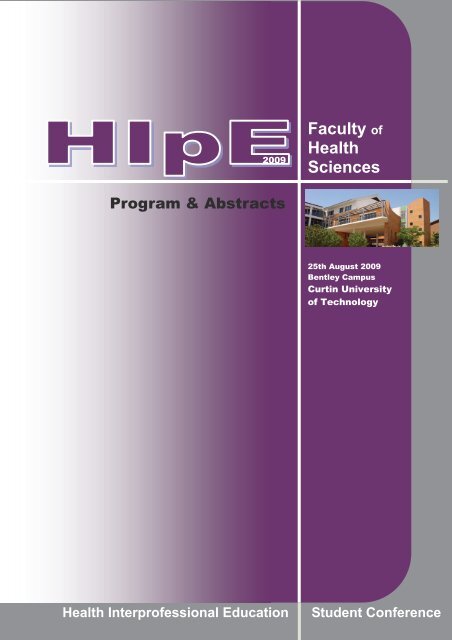
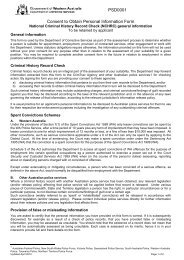
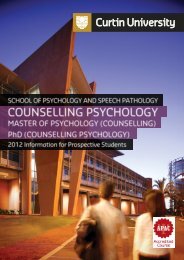
![Mental health commission report July 2010 - June 2011 [.pdf]](https://img.yumpu.com/50755705/1/184x260/mental-health-commission-report-july-2010-june-2011-pdf.jpg?quality=85)
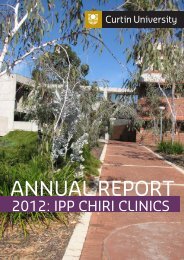

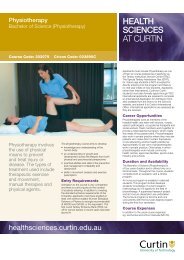
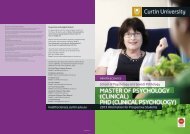
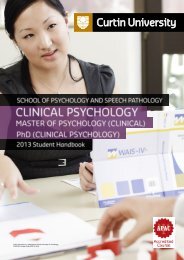

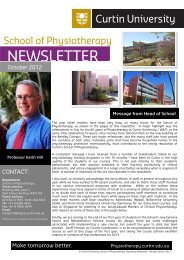
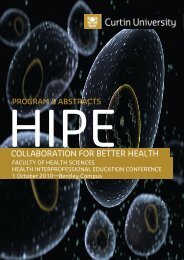
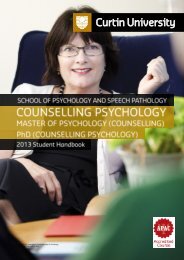
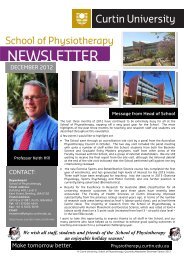
![2007 Annual Report [.pdf] - Health Sciences - Curtin University](https://img.yumpu.com/44476724/1/184x260/2007-annual-report-pdf-health-sciences-curtin-university.jpg?quality=85)